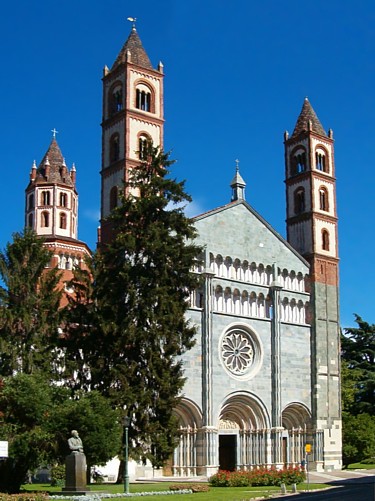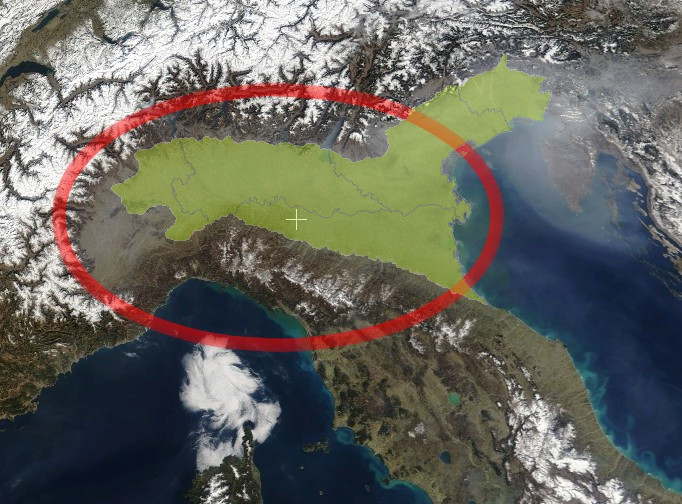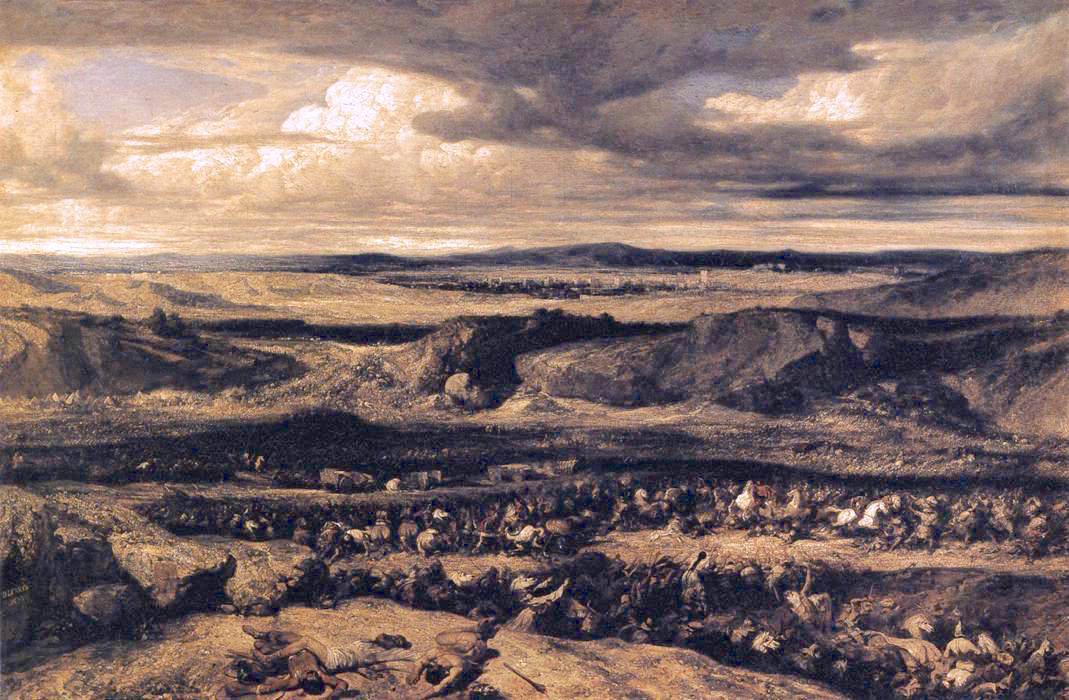|
Vercelli
Vercelli (; pms, Vërsèj ), is a city and ''comune'' of 46,552 inhabitants (January 1, 2017) in the Province of Vercelli, Piedmont, northern Italy. One of the oldest urban sites in northern Italy, it was founded, according to most historians, around 600 BC. The city is situated on the Sesia River in the plain of the Po River between Milan and Turin. It is an important centre for the cultivation of rice and is surrounded by rice paddies, which are flooded in the summer. The climate is typical of the Po Valley with cold, foggy winters ( in January) and oppressive heat during the summer months ( in July). Rainfall is most prevalent during the spring and autumn; thunderstorms are common in the summer. The languages spoken in Vercelli are Italian and Piedmontese; the variety of Piedmontese native to the city is called ''Varsleis''. The world's first university funded by public money was established in Vercelli in 1228 (the seventh university founded in Italy), but was closed in ... [...More Info...] [...Related Items...] OR: [Wikipedia] [Google] [Baidu] |
Eusebius Of Vercelli
Eusebius of Vercelli (c. March 2, 283 – August 1, 371) was a bishop from Sardinia and is counted a saint. Along with Athanasius, he affirmed the divinity of Jesus against Arianism. Biography Eusebius was born in Sardinia, in 283. After his father's martyrdom, he was taken to Rome by his mother, where he later became a lector. He became the first bishop in Vercelli (in northern Italy), probably sometime in the early- to mid-340s. According to a letter of Ambrose to the congregation in Vercelli two decades after Eusebius' death, the local leaders recognized his piety and thus elected him rather than local candidates (''Epistola lxiii, Ad Vercellenses''). Inspired by St Athanasius's ''Life of St Anthony'', he founded a priestly community in Vercelli that resembled a monastic community. This coenobium, in turn, inspired others such as Gaudentius of Novara, Eustasius of Aosta, and Maximus of Turin. He was the first bishop to live in common with the clergy, devoting his best energies ... [...More Info...] [...Related Items...] OR: [Wikipedia] [Google] [Baidu] |
Andrea Corsaro
Andrea Corsaro (born 14 August 1958 in Vercelli) is an Italian politician. Biography He ran for Mayor of Vercelli at the 2004 local elections, supported by a centre-right coalition. He won and took his office on 28 June 2004. Corsaro joined The People of Freedom in 2009 and was elected for a second term at the 2009 local elections. Corsaro ran again for Mayor of Vercelli in 2019 and he won at the second round against the outgoing mayor Maura Forte. He took office on 12 June 2019. See also * 2004 Italian local elections *2009 Italian local elections 9 (nine) is the natural number following and preceding . Evolution of the Arabic digit In the beginning, various Indians wrote a digit 9 similar in shape to the modern closing question mark without the bottom dot. The Kshatrapa, Andhra and ... * 2019 Italian local elections * List of mayors of Vercelli References External links * * 1958 births Living people Mayors of Vercelli People from Vercelli The ... [...More Info...] [...Related Items...] OR: [Wikipedia] [Google] [Baidu] |
Piedmont
it, Piemontese , population_note = , population_blank1_title = , population_blank1 = , demographics_type1 = , demographics1_footnotes = , demographics1_title1 = , demographics1_info1 = , demographics1_title2 = , demographics1_info2 = , demographics1_title3 = , demographics1_info3 = , timezone1 = CET , utc_offset1 = +1 , timezone1_DST = CEST , utc_offset1_DST = +2 , postal_code_type = , postal_code = , area_code_type = ISO 3166 code , area_code = IT-21 , blank_name_sec1 = GDP (nominal) , blank_info_sec1 = €137 billion (2018) , blank1_name_sec1 = GDP per capita , blank1_info_sec1 = €31,500 (2018) , blank2_name_sec1 = HDI (2019) , blank2_info_sec1 = 0.898 · 10th of 21 , blank_name_sec2 = NUTS Region , blank_info_sec2 = ITC1 , website www.regio ... [...More Info...] [...Related Items...] OR: [Wikipedia] [Google] [Baidu] |
Battle Of Vercellae
The Battle of Vercellae, or Battle of the Raudine Plain, was fought on 30 July 101 BC on a plain near Vercellae in Gallia Cisalpina (modern day Northern Italy). A Germanic-Celtic confederation under the command of the Cimbric king Boiorix was defeated by a Roman army under the joint command of the consul Gaius Marius and the proconsul Quintus Lutatius Catulus. The battle marked the end of the Germanic threat to the Roman Republic. Background In 113 BC, a large migrating Germanic- Celtic alliance headed by the Cimbri and the Teutones entered the Roman sphere of influence. They invaded Noricum (located in present-day Austria and Slovenia) which was inhabited by the Taurisci people, friends and allies of Rome. The Senate commissioned Gnaeus Papirius Carbo, one of the consuls, to lead a substantial Roman army to Noricum to force the barbarians out. An engagement, later called the battle of Noreia, took place, in which the invaders completely overwhelmed the Roman Legions a ... [...More Info...] [...Related Items...] OR: [Wikipedia] [Google] [Baidu] |
University Of Eastern Piedmont
The University of Eastern Piedmont "Amedeo Avogadro" ( it, Università degli Studi del Piemonte Orientale "Amedeo Avogadro"; shortened to UNIPMN or UPO) is a university located in Alessandria, Novara and Vercelli, in the region of Piedmont, Italy. It was founded in 1998 and is organized in seven faculties, which before then were part of the University of Turin. Organization These are the seven faculties in which the university is divided into: * Economics * Law * Letters and Philosophy * Mathematics, Physics and Natural Sciences * Medicine and Surgery * Pharmacy * Political Sciences Political science is the scientific study of politics. It is a social science dealing with systems of governance and power, and the analysis of political activities, political thought, political behavior, and associated constitutions and la .... The university also includes an inter-department research centre, the CRIMEDIM (Research Center in Disaster and Emergency Medicine). See als ... [...More Info...] [...Related Items...] OR: [Wikipedia] [Google] [Baidu] |
Sesia
The Sesia (Latin ''Sesites'' or ''Sessites'') is a river in Piedmont, north-western Italy, tributary to the Po. Geography Its sources are the glaciers of Monte Rosa at the border with Switzerland. It flows through the Alpine valley Valsesia and the towns Varallo Sesia, Quarona, Borgosesia and Vercelli. The Sesia flows into the Po River near Casale Monferrato. Main tributaries * Left hand tributaries: ** Sermenza, ** Mastallone, ** Pascone, ** Strona di Valduggia. * Right hand tributaries: ** Sorba, ** Sessera, ** Cervo, ** Naviglio di Ivrea, ** Bona, ** Marcova, ** Roggia Stura. Sport and leisure It is a popular river for kayaking and hosted the European championship in 2001 and the world championship in 2002. ''www.terredelsesia.it'' (accessed in October 2012) See also *[...More Info...] [...Related Items...] OR: [Wikipedia] [Google] [Baidu] |
Pianura Padana
The Po Valley, Po Plain, Plain of the Po, or Padan Plain ( it, Pianura Padana , or ''Val Padana'') is a major geographical feature of Northern Italy. It extends approximately in an east-west direction, with an area of including its Venetic extension not actually related to the Po river basin; it runs from the Western Alps to the Adriatic Sea. The flatlands of Veneto and Friuli are often considered apart since they do not drain into the Po, but they effectively combine into an unbroken plain, making it the largest in Southern Europe. It has a population of 17 million, or a third of Italy's total population. The plain is the surface of an in-filled system of ancient canyons (the "Apennine Foredeep") extending from the Apennines in the south to the Alps in the north, including the northern Adriatic. In addition to the Po and its affluents, the contemporary surface may be considered to include the Savio, Lamone and Reno to the south, and the Adige, Brenta, Piave and Tagliam ... [...More Info...] [...Related Items...] OR: [Wikipedia] [Google] [Baidu] |
Turin
Turin ( , Piedmontese: ; it, Torino ) is a city and an important business and cultural centre in Northern Italy. It is the capital city of Piedmont and of the Metropolitan City of Turin, and was the first Italian capital from 1861 to 1865. The city is mainly on the western bank of the Po River, below its Susa Valley, and is surrounded by the western Alpine arch and Superga Hill. The population of the city proper is 847,287 (31 January 2022) while the population of the urban area is estimated by Eurostat to be 1.7 million inhabitants. The Turin metropolitan area is estimated by the OECD to have a population of 2.2 million. The city used to be a major European political centre. From 1563, it was the capital of the Duchy of Savoy, then of the Kingdom of Sardinia ruled by the House of Savoy, and the first capital of the Kingdom of Italy from 1861 to 1865. Turin is sometimes called "the cradle of Italian liberty" for having been the political and intellectual centre ... [...More Info...] [...Related Items...] OR: [Wikipedia] [Google] [Baidu] |
City
A city is a human settlement of notable size.Goodall, B. (1987) ''The Penguin Dictionary of Human Geography''. London: Penguin.Kuper, A. and Kuper, J., eds (1996) ''The Social Science Encyclopedia''. 2nd edition. London: Routledge. It can be defined as a permanent and densely settled place with administratively defined boundaries whose members work primarily on non-agricultural tasks. Cities generally have extensive systems for housing, transportation, sanitation, utilities, land use, production of goods, and communication. Their density facilitates interaction between people, government organisations and businesses, sometimes benefiting different parties in the process, such as improving efficiency of goods and service distribution. Historically, city-dwellers have been a small proportion of humanity overall, but following two centuries of unprecedented and rapid urbanization, more than half of the world population now lives in cities, which has had profound consequ ... [...More Info...] [...Related Items...] OR: [Wikipedia] [Google] [Baidu] |
Cimbri
The Cimbri (Greek Κίμβροι, ''Kímbroi''; Latin ''Cimbri'') were an ancient tribe in Europe. Ancient authors described them variously as a Celtic people (or Gaulish), Germanic people, or even Cimmerian. Several ancient sources indicate that they lived in Jutland, which in some classical texts was called the Cimbrian peninsula. There is no direct evidence for the language they spoke, though some scholars argue that it must have been a Germanic language, while others argue that it must have been Celtic. Together with the Teutones and the Ambrones, they fought the Roman Republic between 113 and 101 BC during the Cimbrian War. The Cimbri were initially successful, particularly at the Battle of Arausio, in which a large Roman army was routed. They then raided large areas in Gaul and Hispania. In 101 BC, during an attempted invasion of the Italian peninsula, the Cimbri were decisively defeated at the Battle of Vercellae by Gaius Marius, and their king, Boiorix, was ki ... [...More Info...] [...Related Items...] OR: [Wikipedia] [Google] [Baidu] |
Count Of The Empire
As Emperor of the French, Napoleon I created titles of nobility to institute a stable elite in the First French Empire, after the instability resulting from the French Revolution. Like many others, both before and since, Napoleon found that the ability to confer titles was also a useful tool of patronage which cost the state little treasure. In all, about 2,200 titles were created by Napoleon: * Princes and Dukes: **Princes of the Imperial family ***The Imperial Prince (Napoleon's son, Napoleon II) ***Princes of France (8 close family members) ** sovereign princes (3) ** duchies grand fiefs (20) ** victory princes (4) ** victory dukedoms (10) ** other dukedoms (3) * Counts (251) * Barons (1,516) * Knights (385) Napoleon also established a new knightly order in 1802, the Légion d'honneur, which is still in existence today. The Grand Dignitaries of the French Empire ranked, regardless of noble title, immediately behind the Princes of France. Creation Ennoblement started in ... [...More Info...] [...Related Items...] OR: [Wikipedia] [Google] [Baidu] |






